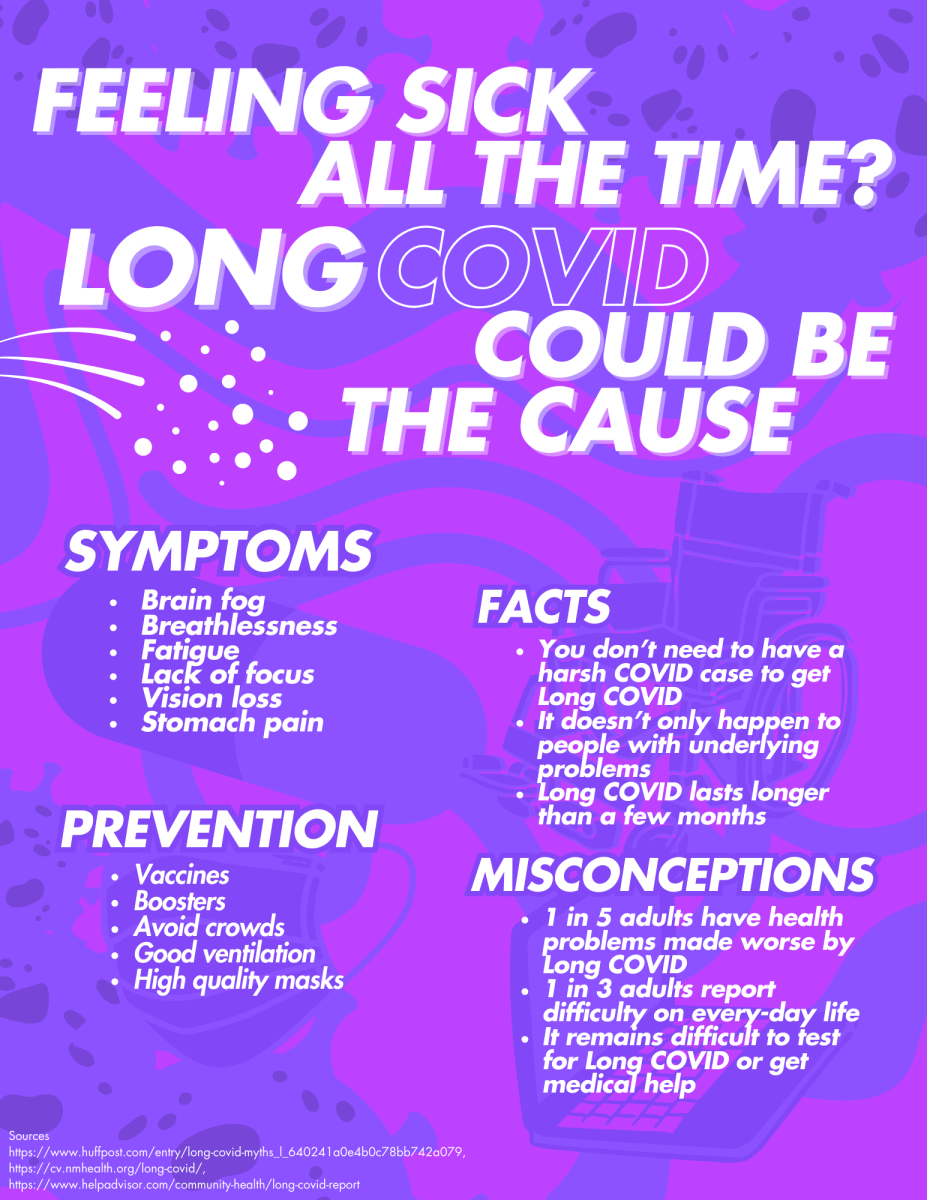With the beginning of school, another COVID-19 infection wave leaves many states on high-risk of new COVID-19 cases. Large portions of the population seem to be largely unaware of the dangers COVID-19 poses to their health, as information remains unavailable.
“I’ve had COVID-19 three times so far,” Aida Grady (10) said. “The first time I had it I was a little worried as it was something I really didn’t know. The second and third time I had it, it was really more of an annoyance.”
COVID-19 is highly contagious and can be transmitted before the carrier shows any symptoms of being infected, meaning that those who carry it may not be aware they can spread it. According to the Center for Disease Control and Prevention (CDC), even after infected people recover from COVID-19, some go on to suffer from Long Covid, a chronic condition which includes a wide range of persistent symptoms such as headaches, brain fog, heart problems, digestion problems, and physical fatigue. Long Covid’s potential danger grows the longer it goes untreated, as according to the University of Nebraska Medical Center, a public academic health science center, every COVID-19 reinfection increases the risks of developing Long Covid, even if the infected person didn’t have any symptoms.
“I wish some people would realize it actually existed,” Grady said. “A lot of people don’t have any of the vaccines due to just believing its fake and I think that’s kind of ridiculous.”
According to a new Pew Research Center (PRC) survey, only 20% of Americans perceive COVID-19 as a threat. Earlier this May, the CDC reported that only 22% of adults were vaccinated. The government’s approach to COVID-19 prevention through herd-immunity has been largely ineffective, with the former Chief Medical Advisor to the president, Anthony Fauci, stating in 2022 that to “return to normal” there would need to be under 3,000 cases per day. The exact number of COVID-19 cases is hard to measure, as the U.S. does not directly track COVID-19 cases, instead relying on hospitalization and vaccination statistics. According to estimates by the Worldometer, an international data reference often used by the British government, throughout the months of January 2024 until March 2024, the last available data point, there were around 20,000 COVID-19 cases a day in the U.S. The CDC reported over 1,000 COVID-19 deaths every week in August 2024, increasing from 300 weekly deaths during May 2024, but lower than 2,300 deaths per week during December 2023.
“For the last two years COVID-19 hasn’t seemed as relevant as it used to,” Grady said. “I would occasionally think about COVID-19 because it didn’t seem to be a factor in my life right now, I found that weird as just a few years prior, it seemed everyone was worried about it.”
During 2020, at the very beginning of the pandemic, the PRC found that 42% of people in the U.S. saw COVID-19 as a major threat, which then increased to 55% only a few weeks later. Ever since President Joe Biden announced that the pandemic was over two years ago, the public’s care for COVID-19 has rapidly declined; however, new research shows that COVID-19 and Long COVID-19 may pose a bigger threat than previously expected. The John’s Hopkins School of Public Health, a public health graduate school and an extension of the larger prestigious John’s Hopkins University, finds that COVID-19 increases risk of serious heart issues, such as blood clots, inflammation, and heart attacks. Dr Ziyad Al-Aly, a physician dedicated to COVID-19 research and Chief of Research and Development Service at the Veteran’s Affairs Saint Louis Health Care System, writes in the newsletter “The Conversation,” that being infected with COVID-19 can lead to long-term brain related issues, such as developing memory problems, brain inflammation, shrinkage of brain volume, brain degradation the equivalent of 20 years of age, heightened risk of a stroke, and an increased risk of dementia.
“I don’t know anyone who discusses it frequently, unfortunately, or really at all for that matter,” Grady said. “While I still fully believe COVID is still relevant it’s not something that seems to be discussed as much anymore and I think a lot less people are aware of its recent appearance now more than ever”
According to the CDC, since April 30, 2024, federal regulation regarding data reporting requirements expired, resulting in important data, such as hospital infrastructure, becoming exclusively voluntarily reported, leading to the number of hospitals regularly reporting data decreasing by nearly two thirds. Similar actions carried by the United States government have been criticized by experts since the start of the pandemic. In 2021, Tanya Lewis, an editor for the Scientific American with a science communications degree who covers health and medicine, wrote that “mistakes were made that together cost hundreds of thousands of lives.” Later in 2023, Dr. Nirav Shah, the CDC’s Principal Deputy, told National Public Radio that since states are not required to report COVID-19 cases, and many people only do home testing, infection statistics are often unreliable.
“I last had it two weeks ago,” Grady said. “I wish it were treated as if it were relevant as opposed to just being shut out.”
Data on COVID-19 remains inaccessible, but the fight is not over. Starting in November 2024, new federal requirements for hospital data reporting could provide scientists with access to more reliable infection and spread data. Staying informed about emerging COVID-19 developments can protect the health of vulnerable individuals and allow for action that prevents the risk of suffering long-term effects.









